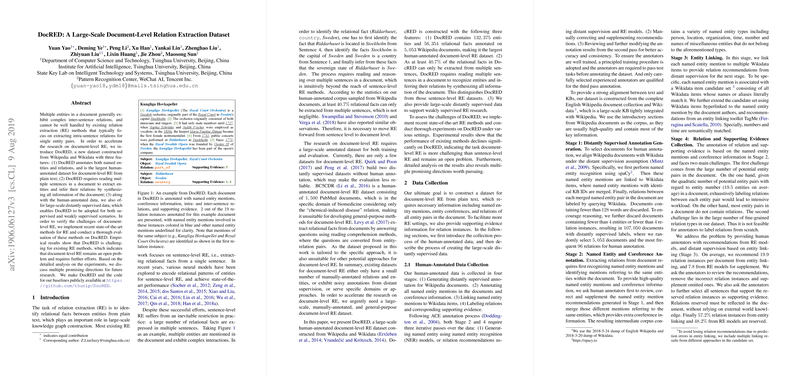An Insightful Overview of "DocRED: A Large-Scale Document-Level Relation Extraction Dataset"
In the paper titled "DocRED: A Large-Scale Document-Level Relation Extraction Dataset," the authors present a novel dataset aimed at advancing the field of document-level relation extraction (RE). DocRED is derived from Wikipedia and Wikidata, offering a robust framework for addressing complex inter-sentence relations that cannot be effectively managed by traditional sentence-level RE methods.
Key Features of DocRED
DocRED represents a substantial leap in the availability of resources for document-level RE by incorporating several defining features:
- Scale and Annotation: It is the largest human-annotated dataset for document-level RE, with over 56,000 relational facts annotated across over 5,000 Wikipedia documents. This scale ensures a wide representation of entity relations.
- Multi-Sentence Context: The dataset is specifically designed to require understanding and reasoning across multiple sentences. This feature distinguishes it from sentence-level datasets, where context is limited to individual sentences.
- Diverse Data Scenarios: Alongside human annotations, DocRED includes large-scale distantly supervised data, enabling its application in both supervised and weakly supervised learning scenarios.
Evaluation and Challenges
The empirical analysis in the paper involved applying state-of-the-art RE models to DocRED, revealing significant challenges:
- Existing models, which perform well on sentence-level tasks, face difficulties with the intricacies of document-level tasks. The necessity to synthesize information from numerous sentences significantly complicates the extraction process.
- A salient statistic is that about 40.7% of relational facts in DocRED require inter-sentence reasoning, illustrating the dataset's complexity.
Implications for Research and Future Directions
The introduction of DocRED opens multiple avenues for both theoretical exploration and practical advancements in AI:
- Model Development: Researchers are encouraged to develop models capable of handling the document-level context more effectively. There is a clear indication that current methods do not suffice for tasks requiring deep contextual understanding and reasoning.
- Reasoning and Comprehension: The dataset propels the need for systems that can perform logical, coreference, and common-sense reasoning across documents, marking a step towards more sophisticated natural language understanding.
- Weakly Supervised Learning: The inclusion of distantly supervised data is an invitation to innovate in noise-tolerant learning techniques, which could refine the application of weak supervision in document-level RE.
Conclusion
DocRED significantly contributes to the field by providing a comprehensive dataset that challenges existing methodologies and calls for novel approaches to document-level relation extraction. The dataset not only enhances the scope for evaluating RE models but also prompts unprecedented research avenues in AI. As researchers engage with this dataset, advancements in the understanding and processing of complex narrative contexts can be anticipated, further bridging the gap between human-level and machine-level text comprehension.
